Abstract
Flexible interconnection transformation of a distribution network using all-control power electronics technology will help to overcome the technical bottleneck of distributed generation (DG) penetration and high-quality power supply in the traditional distribution network. However, the flexible interconnection form that uses back-to-back power electronic converters to replace tie switches has disadvantages such as high cost and large footprint, so its mass promotion and application are bound to be limited. Therefore, a new topology of flexible interconnected distribution network with embedded DC system (FDN+EDC) with a better economy is proposed. Firstly, the topology of FDN+EDC is introduced to improve the controllability level of the distribution network under high percentage DG penetration, and is compared with the conventional flexible interconnection method. Secondly, in order to realize the coordinated optimal economic operation of source, network and load in the FDN+EDC, a dynamic reconfiguration model of switches status and continuous adjustment of flexible interconnection device (FID) are proposed. Then, to achieve a fast and globally optimal solution of the model, a hierarchical coordinated optimization strategy is designed based on an improved particle swarm algorithm for the optimization of discrete and continuous variables. Finally, the validity of the algorithm is verified, and an 88-node FDN+EDC is constructed to verify the advantages of the proposed embedded DC flexible interconnection topology and realize the joint optimal dispatch of network-source-load.
1. Introduction
The broad consensus of modern society on reducing carbon emissions has driven the rapid construction of distributed generation (DG) and various new source-load facilities. The increasing abundance and complexity of source-load devices in the distribution network has posed difficult problems for the control strategy, stability, and economic operation of the distribution network [1]. The traditional distribution network has a single physical structure and limited control means, which has limitations in system operation optimization, scalability, and reliability. Among them, the flexible interconnection device (FID) based on a voltage source converter (VSC) has been widely noticed [2]. This kind of equipment can transform the traditional distribution network flexibly, and make the system highly controllable and flexible, which can effectively solve a series of new problems caused by the access of various source-load devices. Plus, with the application of FID, the traditional distribution network is gradually changing into a flexible interconnected distribution network (FDN) [3].
FDN is defined as a distribution network capable of flexible closed-loop operation, in which multiple regions are connected by FID and have flexible power regulation capabilities [4]. As the key technology in FDN, the research and application of various FIDs have become a hot topic. Soft open point (SOP) is a typical FID, which is usually used to replace the traditional tie switch to realize the flexible closed-loop operation of the distribution network [5]. As people continue to explore the value of SOP applications, related studies have proposed more SOP structures and implementations suitable for different scenarios [6,7]. By adopting an appropriate control strategy for SOP, the distribution network can flexibly dispatch power to realize DG penetration improving [8], feeder load balancing [9], improvement of power quality [10], reduction of network loss [11], and fault isolation and fast power transmission [12].
However, the FID represented by SOP is mainly based on fully controlled power electronic devices with high investment and operation maintenance costs. It is impossible to completely replace the tie switch in the short term and is not conducive to widespread promotion, which means that the problem of how to build a reasonable and economical flexible interconnection topology in the process of comprehensive upgrading of the distribution network by FID remains to be solved.
In the process of searching for solutions to the above problem, inspired by the SOP-derived flexible multi-state switch (FMS) [13,14] structure, this paper proposes a new flexible interconnection topology form in which tie switches and FIDs coexist. On the basis of retaining the existing distribution network power supply form, it uses the embedded DC system (EDC) parallel connection to reconfigure the distribution network from the physical aspect in order to form a flexible closed-loop power supply distribution network form. Due to the introduction of the DC system, the structure uses a smaller number of fully controlled power electronic converters, with better economic costs and higher scalability.
Since the tie switch is still completely retained in the new topology, the original operation control method of the distribution network—network reconfiguration can still give full play to its advantages. The literature [15,16,17] uses network reconfiguration and SOP in conjunction with each other to solve the problems of loss optimization, feeder load balancing, and DG penetration in the distribution network. However, in these studies, SOP has been optimized after replacing the tie switch, ignoring the joint optimization in the coexistence state of tie switches and SOP. In order to solve this problem, a dynamic reconfiguration optimization model is proposed in the form of fully coexisting tie switches and FID, and an improved particle swarm algorithm is used for hierarchical coordinated optimization to obtain the optimal power of FID and switch scheduling operation.
The main contributions of this paper are as follows.
- (1)
- A new topology of flexible interconnection with better economy is proposed to form a flexible closed loop of the distribution network by EDC, which has high application value in practical application and is suitable for gradual promotion.
- (2)
- A gap is filled in the optimization problem of dynamic reconfiguration of FDN+EDC in the form of complete coexistence of tie switches and FIDs, and a hierarchical coordinated optimization solution method involving an improved particle swarm algorithm is proposed.
The rest of this paper is organized as follows. Section 2 first introduces the characteristics and advantages of the FDN+EDC. Section 3 proposes a dynamic reconfiguration model for FDN+EDC, that is, the tie switch and the FID coexist completely. The model solving method is explained in Section 4. The case study analysis is given in Section 5. Conclusions are drawn in Section 6.
2. Flexible Interconnected Distribution Network with Embedded DC System
As shown in Figure 1, the current flexible interconnection method used in the FDN is mainly SOP or FMS that replaces the traditional mechanical tie switch between feeders [18,19], which concentrates multiple converters at the tie switch node and has the following drawbacks: (1) arranged at the feeder liaison point, the dynamic voltage support for feeders with a high proportion of DG is insufficient, and it is difficult to solve the problem of DG penetration capacity limitation on the AC side of the traditional distribution network; (2) multiple tie switches between multiple feeders require a large number of replacement converters, raising construction costs and operating losses; (3) the original distribution automation system needs to be modified for support, making it difficult to promote the application.

Figure 1.
Existing flexible interconnection forms: (a) replacing tie switches with SOP; (b) replacing tie switches with FMS.
In order to solve the above shortcomings, this paper proposes a flexible interconnection topology with embedded DC system inspired by the FMS topology in Figure 1b.
2.1. Topology
Figure 2 shows the topology of FDN+EDC. As can be seen from the Figure 2, each VSC is connected to a node in the power supply area, and is interconnected with the remaining VSCs through a DC line to form an embedded DC system. The implication of embeddedness here is that the location of each VSC in each power supply region is not fixed at the end of each tie switch node or feeder as in most studies. Its node selection can be optimized by referring to the literature [20,21], so the whole DC system is like being embedded in the distribution network. Plus, due to the introduction of embedded structures, the original power supply form of the distribution network is preserved. Similarly, with the increase of power electronic interconnection devices, the entire distribution network structure has the flexible closed-loop function, more flexible operation, and higher reliability.
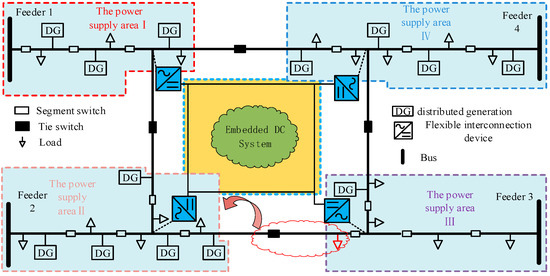
Figure 2.
Flexible interconnected distribution network with embedded DC system.
As shown in Figure 1a, SOP composed of back-to-back converters directly replaces the tie switch. It uses the largest number of VSCs and has the lowest economy. Although the topology of this paper is inspired by the FMS structure with the same number of VSCs used, the EDC topology of this paper is intrinsically different from Figure 1b. First, the EDC is directly connected from a certain node of the feeder. The node selection can be further optimized instead of being fixed at the tie switch node. After that, other areas are interconnected through the DC line to form a distributed DC network. There is only active power loss on the DC line, and the reactive power support provided by VSC can be compensated locally in time. In Figure 1b, the centralized multi-terminal interconnection at the end of the feeder is connected to the AC system through a section of AC line. The excess line loss is related to the transmitted power. Due to the distance, the reactive power support provided by the VSC has some losses on the line, so the topology of this paper has some advantages in the excess losses caused by power regulation and timely reactive power support role. Second, the topology in this paper also has advantages in distribution automation systems. For example, FDN+EDC is directly connected at the load node, and its communication can directly utilize the original equipment at the load node, while FMS needs to rebuild the existing communication system due to the distance. Third, in the embedded DC topology, the DC network is more suitable for a large number of diversified sources and loads than the centralized multi-terminal interconnected DC part at the end of the feeder, and its scalability is stronger.
Since the original switchgear still exists, FDN+EDC can use the tie switch and the segment switch to adjust the power supply area. For example, in Figure 2, DG in power supply area II is sufficient, while the load in power supply area III is large, so the switch action can be used to transfer part of the load in area III in priority to expand the power supply area II.
At the same time, the VSCs in the topology of this paper are not simply similar to double-ended back-to-back voltage source converters, and their functions are diverse. As shown in Figure 3, if the power supply area IV is extended due to switch action, the two connected VSCs have a parallel relationship, the power can be transmitted from the bottom to the large power supply area IV via these two VSCs, respectively, and the VSCs can be further optimized in capacity design because of this parallel relationship.
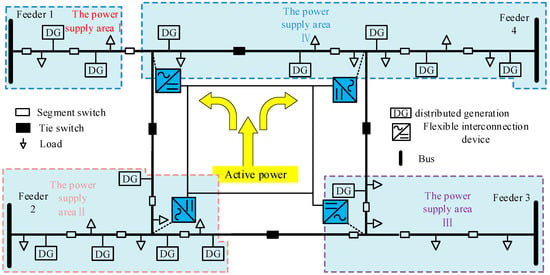
Figure 3.
Flexible interconnected distribution network with embedded DC system.
2.2. Operation Mode
During normal operation, the EDC topology can achieve the same permanent “soft connection” as other flexible interconnection topologies in each power supply area of the distribution network, providing continuous active regulation and reactive power support, achieving feeder load balancing, network blockage relief, voltage quality management, etc. In addition, due to the presence of the original switchgear, the topology of the power supply can be adjusted based on the switching action, which is conducive to grid regulation and operation.
In the event of a fault in the distribution network, the FDN+EDC can also achieve the functions of fault isolation, power flow transfer, and power restoration. Likewise, due to the presence of the original switchgear, tie and segment switches can play a role in transferring power loads, and the interplay with the EDC topology can achieve an optimal allocation of VSC capacity in the topology with high technical economy.
From the perspective of distribution network operation and management, the FDN+EDC achieves a high degree of controllability and flexibility of the distribution network. Compared with the direct replacement of tie switches by existing FIDs, the FDN+EDC has the complete coexistence of switches, FIDs and DC networks, which results in lower costs for flexible interconnection transformation of the distribution networks. Plus, in order to realize the economic operation in the new topology form, the value benefit from the coordination and optimization of the EDC in the topology with the existing switch dynamic reconfiguration scheduling method will be more obvious.
3. Dynamic Reconfiguration Optimization Model
Drawing on the research ideas and methods related to SOP and network reconfiguration coordination optimization in the literature [15,16,17], this section uses the original network reconfiguration technology of the distribution network for the network dynamic reconfiguration based on the embedded DC flexible interconnection form proposed in the previous subsection.
Unlike previous studies, the new topology proposed in this paper increases the dimensionality of the problem solution because all the original switches are retained, and the addition of the DC network makes the system optimization require a more comprehensive consideration of the role of each component.
3.1. Objective Function
For the economical, safe, and stable operation of the system, this paper takes the minimum active power loss and AC node voltage offset of the distribution network as the optimization goal. The objective function is as follows:
where f1 is the active loss, T is the number of periods in the reconfiguration cycle, Pt,Loss·AClinei is the loss on AC line i at time t, n is the total number of AC lines in operation, Pt,Loss·DClinej is the loss on DC line j at time t, m is the total number of DC lines in operation, Pt,Loss·VSCk is the kth converter loss at time t, and K is the number of VSCs in operation. Equation (1) in the detailed calculation of each loss is shown in Equation (3). f2 for the total voltage offset, NL for the number of AC load nodes in the system, Vt,l for the load node l in t time the actual voltage, for the desired voltage value, generally 1.0 p.u., Δ for the maximum allowable voltage deviation, where: Δ = − . , are the maximum and minimum allowable voltage of l-node, respectively, which are set to 1.1 p.u. and 0.9 p.u. in this paper.
where It,i is the current of AC line i at time t, ri is the resistance of AC line i, It,j is the current of DC line j at time t, rj is the resistance of DC line j, Pt,VSCk, Qt,VSCk is the active and reactive power of the kth VSC at time t, and β is the loss factor, which is taken as 0.02 in this paper.
Since the objective function involves multi-objective optimization, this paper uses a weighting method to convert the multi-objective into a single objective for optimization, but the two objective functions have different magnitudes and cannot be weighted directly, so the two objectives are first normalized to make them comparable.
where Ploss0(t), dV0(t) are the active loss and voltage offset calculated by the power flow in the initial state at time t. Plossmin(t), dVmin(t) are the optimized values obtained by using the optimal regulation technique to minimize the active loss and voltage offset, respectively, at time t as the single objective optimization.
Using the weighted method to process the two objective functions of Equations (1) and (2), the total objective function is obtained as:
where λ1 and λ2 are the weight coefficients of each target, which are greater than or equal to 0 and satisfy λ1 + λ2 = 1. In this paper, λ1 = 0.6 and λ2 = 0.4 are selected.
3.2. System Constraints
3.2.1. Power Balance Constraints
The power constraints mainly include the power balance at the AC system, DC network, and VSC in the network, and the expressions are as follows.
- AC side power balance constraint
- DC side power balance constraint
- Power balance at VSCwhere ΔPi(t) and ΔQi(t) are the active and reactive power deviations of AC node i at time t, ΔPdcm(t) is the active power deviation of DC node m at time t, Pgi(t) and Qgi(t) are the active and reactive power of the power supply at AC node i at time t, Pli(t) and Qli(t) are the power of the load, Psi(t) and Qsi(t) are the power flowing through VSC injected into node i at time t. Gij + jBij, θij(t) are the conductance between AC nodes i and j, phase angle at time t, and Pgdcm(t) and Pldcm(t) are the power supply and load power at DC node m at time t. Pcdcm(t) is the active power injected into DC side m by the converter at time t. Gdcmn is the line conductance between DC nodes m, n. Pt,DC·VSCk is the power injected into its DC side portion by the kth VSC at time t.
3.2.2. System Security Operational Constraints
The system security operating constraints are as follows.
where Ui is the voltage amplitude of each node in the network, Umin and Umax are the allowable voltage extremes of each node of the system, respectively; Sij is the line power and Sijmax is the maximum allowable transmission capacity of the line.
3.2.3. Converter Capacity Constraints
The converter capacity constraints are as follows.
where is the kth VSC capacity and μ is the VSC reactive power constraint factor, which is taken as 0.9 in this paper.
3.2.4. Network Topology Constraints
In the reconfiguration process of the distribution network, there should be no line ringing and islanding in the AC network except the embedded DC system, and the radial network topology should be maintained.
3.2.5. Switching Action Number Constraints
During the reconfiguration of the distribution network, the service life of the switches and the switching costs need to be taken into account, so there are constraints on the number of operations of all switches and individual switches during the reconfiguration.
xk,t, xk,t−1 is the switching state of the kth switch in time period t, t − 1, x takes the values of ‘0, 1’, ‘1’ is the operating state, ‘0’ is the disconnected state, T is the reconfiguration time period, S is the total number of operable switches, xkmax is the limit of the number of individual switch operations, and xmax is the limit of the number of all switch operations during the reconfiguration time. In this paper, xkmax = 3 and xmax = 45.
4. Solution Methodology
In this section, the problem model is solved using a hierarchical coordinated optimization method involving an improved particle swarm algorithm. The improved particle swarm algorithm used is first introduced, then algorithm realization is descried to solve the problem of switching variable optimization in network reconfiguration. Finally, dynamic reconfiguration rules and hierarchical coordination optimization method between discrete variables such as switching and continuous variables such as control ability of FID are presented under the new topological form.
4.1. Improved Particle Swarm Algorithm
Particle swarm algorithms are widely used in network reconfiguration problems because of its simple programming and high efficiency [22]. In order to overcome the shortcomings of the traditional particle swarm algorithm which is easy to fall into local optimum, this paper introduces a shrinkage factor to control the size of the particle motion speed [23], which can make the convergence of particle swarm optimization faster and still move fast in the search space if an optimum point is found in the case of early convergence. This also reduces the impact of inappropriate choice of upper and lower speed limits on the performance of the algorithm. The specific expressions are as follows.
where η is the velocity-limited factor, generally taken as 0.729, c1, c2 are the individual learning factors and social learning factors, r1, r2 are random numbers between [0, 1], pid, pgd represent the individual extremes and global extremes, respectively, ωmax and ωmin are the maximum and minimum values of ω, which are taken as 1.2 and 0.2, respectively, in this paper, Tmax is the maximum number of iterations, t is the iteration number of iterations, v ∈ [−vmax, vmax], vmax is the velocity limit, and the position x of the particle denotes the solution of the problem.
4.2. Coding of the Problem Solution
In distribution network reconfiguration, the encoding of the problem solution is an important link. If ‘01’ is used directly to set the corresponding operation state of each switch for the optimization, the dimensionality of the solution vector in the optimization process is large, and a large number of infeasible solutions are easily generated, which affects the speed of the algorithm for the optimization. Therefore, in this paper, the method proposed in the literature [24] is used to encode the solution vector, that is, all switches in the network are first closed, the number of basic loops in the network is used as the dimension of the problem solution, and the number of loop switches is the encoding method of the solution content, which reduces the dimensionality of the solution and the generation of infeasible solutions. In addition, the loop switch numbers correspond to consecutive sequential integer values starting from 1 in this paper for the sake of simplicity in programming implementation.
4.3. Update of Particles
From the previous subsection, each dimension of the particle represents the integer number of the switch in the loop that was selected as the tie switch (disconnected), so that the update of the particle can be performed by the following equation.
where xidt+1 ∈ [1, d], d is the total number of switches in the corresponding loop, and the corresponding switch is in a branch group that is not selected by other loops. The update is successful if the network node is not islanded after disconnecting the corresponding switch; otherwise, an integer r satisfying the condition between [1, d] is randomly generated, and xidt+1 = r is set to continue updating the next dimension of the particle. This makes the updating of particles highly feasible, and local variation increases the diversity of particles, preventing the algorithm from falling into local optimization and premature maturation.
4.4. Dynamic Reconfiguration Rules
In this paper, one day is firstly divided into 24 h, and the single-period multi-objective optimization of the optimal active power loss and voltage offset is carried out in each unit period, and the unit periods with the same topology are preliminarily merged. Then calculates the active power loss and voltage offset in each period after the initial merging. Since reconfiguration itself is about optimizing the system state to the maximum extent possible by changing the switching state, the reconfiguration periods can be further combined according to the active loss period loss reduction ratio and the time period voltage offset optimization ratio.
where ξTk(k) is the active loss time period degradation ratio of the kth time period reconfigured in Tk mode, PlossTk(k) denotes the active loss of the system in the kth time period after reconfiguration in Tk mode, and Pload(k) denotes the active loss in the kth time period in the initial state of the network. γTk(k) is the optimized ratio of time slot voltage offset for the kth time slot reconstructed in Tk mode, αTk(k) is the value of dynamic optimization effect for the kth time slot reconstructed in Tk mode, and λ1, λ2 are the ratio focus coefficients, which take the same value as Equation (5) here.
Further merging of the initially merged time slots according to αTk(k), with each merging starting from the time slot tk with the smallest value of αTk(k) (because the smaller αTk(k) indicates the smaller optimization effect brought by the reconfiguration of that time slot). If the time period is the first or last time period, it is directly merged with its neighboring time periods, and the reconfiguration is conducted in the same way as the reconfiguration of its merged time period, otherwise αTk−1(k) and αTk+1(k) are compared. If αTk−1(k) > αTk+1(k), the kth and k − 1st time periods are merged and the reconfiguration method is Tk−1. If αTk−1(k) < αTk+1(k), the kth and k + 1st time periods are merged, and the reconfiguration method is Tk+1. After processing, the time slots and optimization strategies are updated, and if the adjacent time slots are reconstructed in the same way, they are combined. Finally, determine whether the number of network switches required to update the merged reconfiguration satisfies the number of constraints and the limit on the number of reconfiguration periods. If it is satisfied, the time slots will not be merged, otherwise the above cases will continue to be processed based on the dynamic optimization effect values.
4.5. Dynamic Reconfiguration of Hierarchical Coordination Optimization Methods
In Section 4.4, the dynamic reconfiguration requires the use of unit-time optimization results, and the optimization variables are the switching state and VSC power. In addition, the combined switching reconfiguration approach requires updating the VSC optimal control strategy under this scheme, i.e., the switching action discrete variables interact with the VSC power control continuous variables; therefore, a hierarchical coordinated optimization approach is proposed to solve the mutual coupling of these two variables.
In the hierarchical coordinated optimization process, in the first layer, in order to obtain the static optimization results for each hourly single period, the optimization adjustment variables are the switching state and VSC power for each period, and the optimization variables contain continuous and discrete variables. In order to achieve the coordinated optimum between the two variables, a two-layer optimization method is implemented, in which the upper layer uses the reconfiguration algorithm of this paper to optimize the switching state discrete variables and the lower layer uses the improved particle swarm algorithm of Equations (12) and (13) of this paper to optimize each VSC power continuous variable.
The second layer considers the number of switches actions and uses this paper’s dynamic reconfiguration method to adjust the switch states and achieve dynamic reconfiguration of the network.
Therefore, the specific flow of dynamic reconfiguration under the topological form of this paper is shown in Figure 4.
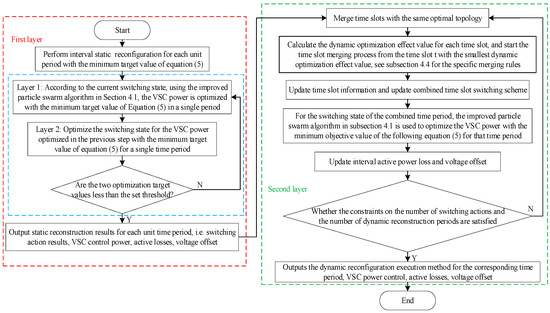
Figure 4.
Dynamic reconfiguration flowchart.
5. Case Studies and Analysis
In this section, the IEEE 33-node system is used to demonstrate the efficiency and accuracy of the improved particle swarm algorithm proposed in this paper for network reconfiguration. Then, a four-area power supply interconnected 88-node system is constructed by adding an embedded DC model for arithmetic modification based on the IEEE 33-node system data. On this system, the advantages of the topology in this paper and the FMS topology are quantitatively compared and verified. Finally, dynamic reconfiguration is introduced into the modified system to verify and analyze the results.
5.1. Network Reconfiguration Analysis of IEEE33-Node System
As shown in Figure 5, the IEEE33-node system has 32 load nodes, 1 power node, 5 tie switches, the initial state disconnected switches are 33, 34, 35, 36, and 37, the initial network loss is 202.677 kW, the lowest node voltage is 0.883 p.u., using the algorithm proposed in this paper repeatedly reconstructed 200 times, and the results were compared with the algorithm in the literature [25]. The results are shown in the Table 1, and the comparison of the computational efficiency is not given because of the difference of the computational environment. The average computation time of this paper is 32.431 s.

Figure 5.
IEEE33-node system.

Table 1.
Method comparison results.
From the results in Table 1, it can be seen that the algorithm proposed in this paper is similar to another algorithm in terms of optimal reconfiguration results, and the reason for the difference in the results of network loss mainly stems from the fact that there is a certain numerical error in the calculation of the distribution network power flow and network loss. The comparison results fully prove the effectiveness of the algorithm in this paper. In addition, among the 200 reconfiguration results, the maximum network loss value, the average network loss value, the average network loss reduction value, and the standard deviation of this paper are significantly better than another algorithm, which indicates that the algorithm proposed in this paper has good robustness.
5.2. Modified 88-Node System Based on IEEE 33-Node System
In this paper, a four-area power supply system with 88 nodes is constructed based on the original IEEE33 node data modified, as shown in Figure 6. Node 1 is the power node, the rest of the nodes are load nodes, and the whole system contains 8 tie switches. The variation of load and DG output of the whole system is shown in Figure 7. Load power changes are based on the percentage distribution of load per node at the initial moment, i.e., the change in load power is consistent with the overall load power change trend of the system and is distributed according to the given operating curve, whereas the total initial load of the network occurs at 15 h. The DGs in each zone are operated at a unity power factor. Plus, the PV output is consistent within the same area, as are the turbines. Due to the embedded DC system, the regions become diverse in interconnection forms and more reliable in power supply, where the capacity of all four VSCs is set to 2 MVA. The reference voltage in this paper is 12.66 kV, and the reference capacity is 100 MVA.
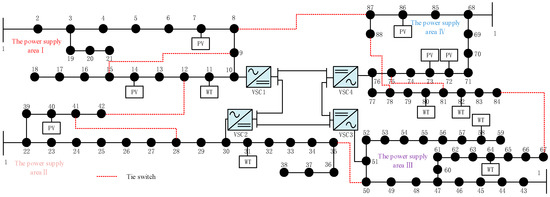
Figure 6.
Modified construction of 88-node four-zone power supply system.
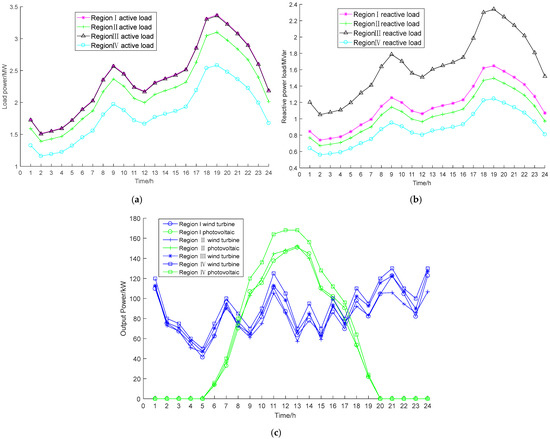
Figure 7.
System initial data: (a) active load in each region; (b) reactive power load in each region; (c) DG contribution in each region.
5.3. Comparison of FDN+EDC and FMS Topology
The FMS topology is shown in Figure 8, where each VSC is connected to a node via a section of AC line. Although the number of VSCs used in the FMS is the same as the topology in this paper, there are some structural differences between the two, which bring different optimization effects. Therefore, this part selects the 19 h load and DGs output data to compare the optimization results of the two. In most of the literature, the FMS directly replaces the tie switch without considering the switch participation in the optimization. So, in this part, an FMS optimization topology with switch participation is considered in topology comparison, and the optimization objectives are both active loss and voltage offset minimization.
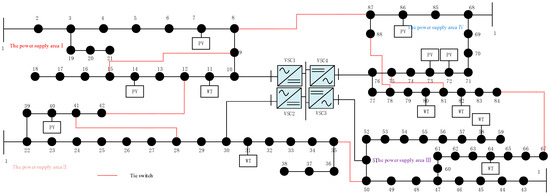
Figure 8.
FMS topology.
Table 2 shows the AC and DC line parameters added to the topology of FMS and this paper. Due to the need for comparison, the distance and type of each added line are kept consistent. VSC1–4 are controlled by PQ, PQ, PQ, and UdcQ, respectively, where Udc is always kept at 1.0 p.u. The DC side loss of FMS topology is neglected because of the short distance of the DC part. Meanwhile, the topology of this paper is directly connected to the system node, and the distance of the connected part of the AC line is too short, so the loss of this part is also ignored. The optimization results are shown in Table 3 and Figure 9.

Table 2.
Newly added line parameters.

Table 3.
Comparison of FMS and EDC topology optimization results.
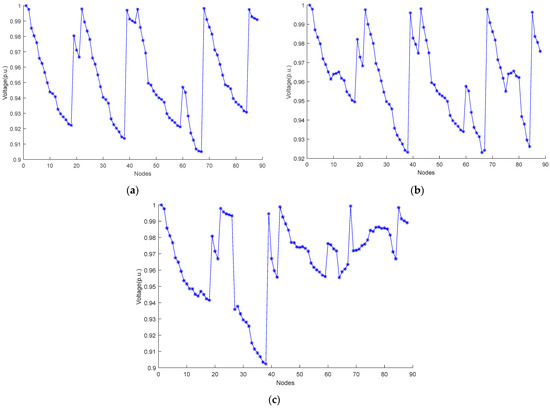
Figure 9.
Voltage levels after optimization of each topology: (a) FMS; (b) FMS+Switch; (c) FDN+EDC.
As can be seen from Table 3 and Figure 9 optimization results, the overall optimization level of the system increases when the switch optimization is taken into account, illustrating the greater benefit of the switchgear and flexible interconnection topology working in conjunction with each other.
The EDC topology directly connected to the node, which can form power mutual aid to the load of the node and its surrounding nodes, adjust the connection area. At the same time, the original switchgear can still be optimized, and the two work together to optimize the best effect. As for FMS, due to the existence of some new AC lines, VSC output active and reactive power is lost in this section of the line. Although the DC line in the EDC is the same as the new AC line in the FMS, there is only active power loss in the DC line, and it can be seen from Table 3 that the active power transmitted by each VSC is not large, so the overall loss is better. In addition, the FMS structure is not as optimized as the EDC topology even with the addition of switching regulation measures.
It is also worth noting that when FMS and FDN+EDC are introduced separately on the original topology, if both are optimized with a single objective of minimizing the active losses in the whole network without considering switching actions, the obtained results can be further compared for both topologies under the same circumstances. The obtained optimization results are shown in Table 4.

Table 4.
Optimization results of introducing FMS/FDN+EDC topology in the initial state, respectively.
As can be seen from Table 4, both the FMS and FDN+EDC topologies can optimize the system when all the original switches are inactive, but in general, the FDN+EDC topology has better optimization results. For the active power transmitted by each VSC, the active power finally injected into the VSC from the AC side will be reduced due to the existence of a new section of AC line in the FMS, while the reactive power transmitted on this section of line needs to be further considered due to the objective of minimizing the overall active power loss of the system, resulting in the FMS reactive power support role being inferior to that of the FDN+EDC. This indicates that under the same switching topology, FDN+EDC has better regulation performance.
So, compared with the flexible multi-state switch interconnection topology, the topology proposed in this paper has more advantages and better results in the optimization of the distribution network operation.
5.4. Influence of Different Control Modes of Each VSC on FDN+EDC
Under normal operation, the control mode of EDC topology is mostly master–slave control. The control mode of each VSC can be divided into PQ or UdcQ control. The VSC controlled by UdcQ is the master station, and the rest are slave stations. This section mainly discusses the impact of different control modes of each VSC under master–slave control on the topology of this paper. It is also optimized with the goal of minimizing the active power loss and voltage offset. The optimization period is 19 h single time section and the optimization results of each control mode are shown in Table 5.

Table 5.
Optimization results for different control modes of VSC in FDN+EDC topology.
As can be seen from Table 5, the power transmitted by each VSC does not differ much when different VSCs are used as masters. The reason is that the P and Q of the VSC transmission as control variables, each port plays a role in the system, and the output power can have a better value in satisfying multiple targets, i.e., the optimal value of the output power of each port is basically fixed.
When VSC4 is used as the master station, there are differences in its switch optimization, but the optimization effect is the best. Because the area connected to VSC4 is rich in DG resources and has a light load, power can be mutually aided in other areas, and the active power output accounts for the largest proportion. It can have a better influence on the whole DC system as the master station, which in turn makes the AC part voltage stable and facilitates the switching action. The voltage of the DC part under each control mode is shown in Figure 10. It can be seen that when the VSC4 is used as the master station, the voltage level of the DC part is the best.
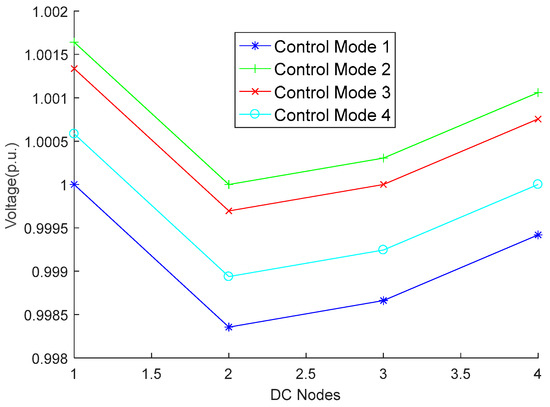
Figure 10.
Voltage at each node of DC system in different control modes.
5.5. Impact of VSC Decommissioning on FDN+EDC
This section focuses on the impact on system optimization when some VSCs in the proposed topology are taken out of operation due to maintenance or fault lockout during steady-state operation. From the analysis of the results in the previous subsection, it is clear that the selection of the master station is mainly on the lighter side of the load for better system optimization. Therefore, in the case of decommissioning, the order of master selection is VSC4 > VSC2 > VSC1 > VSC3. The optimization results are shown in Table 6.

Table 6.
Optimization results in case of partial VSC decommissioning.
From Table 6, it can be seen that the overall optimization effect is lowest when the VSC with heavier load in the connected area is retired. Such as VSC3, because the greater the load, the greater the power optimization effect played by VSC, and at this time the greatest impact caused by VSC decommissioning. However, since the switching device is retained in the topology, the switch can be used to optimize the network during operation in order to keep the system at a good level.
5.6. Dynamic Reconfiguration Optimization
For the topology proposed in this paper, this section introduces dynamic reconfiguration optimization based on it, and the switching actions of each period are set as the start time of the period. The number of dynamic reconfiguration periods is limited to three for the whole day. The obtained results are shown in Table 7 and Figure 11.

Table 7.
Network dynamic reconfiguration optimization results.
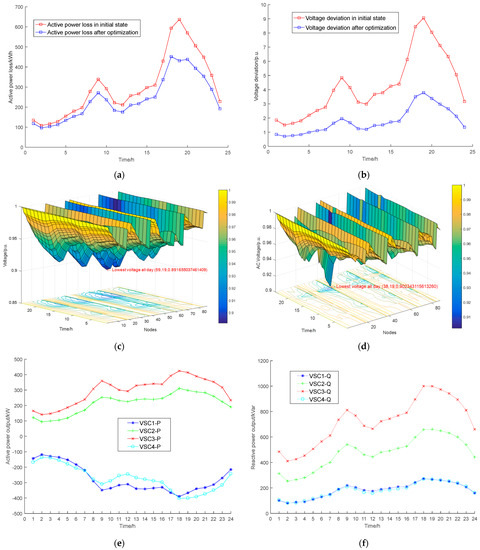
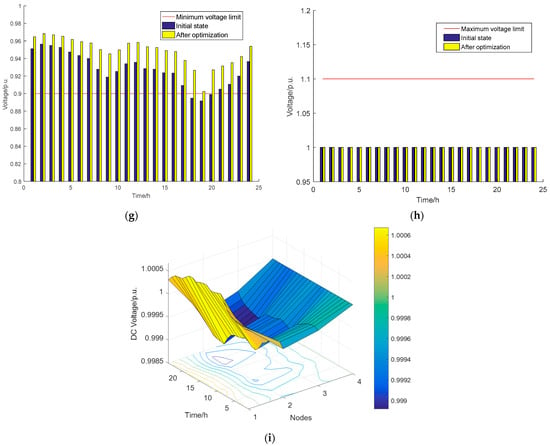
Figure 11.
Dynamic reconfiguration optimization results: (a) 24 h active loss change; (b) 24 h voltage offset variation; (c) voltage distribution in the initial state; (d) 24 h voltage level after dynamic reconfiguration optimization; (e) 24 h active power output of each VSC; (f) 24 h each VSC reactive power output; (g) 24 h system load node minimum voltage; (h) 24 h system node maximum voltage; (i) 24 h DC side voltage situation.
Table 7 shows that the active power loss of the entire network is 7263.7789 kWh under the initial conditions, and this value mainly represents the system network loss value. As the topology of this paper introduces an embedded DC system, the resources of each region can be regulated and mutually beneficial. At the same time, the dynamic reconfiguration optimization can make the switchgear and the FID cooperate with each other. The active power loss of the whole network is AC and DC line loss and VSC loss, and the all-day losses are 5783.1496 kWh. Compared with the initial state, the loss of the dynamic reconfiguration optimization method on the topology of this paper decreases by 20.38%, and the loss reduction effect is obvious. The optimization in this paper is also better in terms of voltage offset, while, as shown in Figure 11b, the trend of voltage offset variation is approximately the same as the initial state, and is, also, consistent with the network load variation.
In one day, the network was reconfigured three times, and each reconfiguration period scheme was maintained at 1–18 h, 19 h, and 20–24 h. When considering the dynamic network reconfiguration, due to the need to consider the number of switching actions, the selection of the action period is obtained by combining the static optimization results per hour. Since the dynamic optimization effect is the best in 19 h, the optimization plan is always reserved, that is, the heavier the load, the optimization brings the best results.
In the topology of this paper, power supply regions I and IV contain abundant DGs, so the VSCs connected to these two regions deliver power to the rest, as in Figure 11e. As far as the reactive power output from VSC is concerned, the reactive power required in areas II and III is larger, so the reactive power support role of VSC connected to these two areas is larger.
Figure 11d,i shows the topology voltage variation in this paper, and it can be seen that the voltage level is significantly improved after the topology optimization compared to the AC voltage distribution in the initial state. At the same time, the DC side of the topology in this paper is not connected to the load and only transmits the power regulated by each area. The DC side voltage level is better, and the fluctuation is small.
In addition, as shown in Figure 11g,h, the optimized system minimum voltage is always within the limits and better than the hourly minimum voltage in the initial state during each hour. Due to the overall heavy load of the topology system in this paper and the small level of DG output, the highest voltage of the entire AC system is always the power node, which is kept at 1.0 p.u., and no voltage violation occurs.
In summary, with the addition of the embedded DC system, the ability of the VSC to regulate the power flow can effectively utilize the resources of each area, which helps to reduce the loss and voltage offset to a certain extent. Due to the significant benefits in network loss reduction and voltage optimization, network reconfiguration can further optimize network operation by regulating resources on the basis of embedded DC systems. The coordinated combination of the two regulation methods significantly improves the overall network loss and voltage quality, and, also, proves the positive effect of the embedded DC model on the operation and management of the distribution network when combined with the traditional regulation methods of the distribution network.
6. Conclusions
A new flexible interconnection topology with embedded DC system is proposed, which can realize the flexible interconnection under the complete coexistence of tie switch and FID without changing the original distribution network power supply form. Compared with the flexible interconnection constructed by replacing the tie switch in the traditional form, the FDN+EDC is a suitable topology for flexible interconnection transformation. In order to achieve economic operation, dynamic reconfiguration optimization is introduced on the basis of the new topology, and the dynamic reconfiguration of the power supply area is achieved using a hierarchical coordinated optimization method involving an improved particle swarm algorithm. The results show that the new topology has obvious advantages in system optimization and regulation. The active loss of the network throughout the day after dynamic reconfiguration has decreased by 20.38%, with an obvious loss reduction effect, while the voltage level has also been well improved.
Further research in the future will focus on the selection of the location and capacity of embedded DC systems in the flexible interconnection transformation of the distribution networks as a way to achieve the solution of the FDN+EDC economic planning problem. Feasible and efficient optimization methods considering DG stochasticity in the new topology form will also be further explored. So that the overall operation level of the system and the robustness of the control strategy can be better improved.
Author Contributions
Conceptualization, H.C. and X.Y.; methodology, H.C. and X.Y.; software, H.C. and W.X.; validation, H.Z., Y.X. and Y.C.; formal analysis, X.Y. and W.X.; investigation, Y.X. and Y.C.; resources, X.Y.; data curation, H.C. and J.Z.; writing—original draft preparation, H.C.; writing—review and editing, X.Y.; visualization, W.X.; supervision, H.Z.; project administration, X.Y. and H.Z.; funding acquisition, X.Y. and H.Z. All authors have read and agreed to the published version of the manuscript.
Funding
This work was supported by National Natural Science Foundation of China (NSFC) (No. 52067004), Guizhou Provincial Science and Technology Projects (ZK[2022] General 154; [2022] General 012).
Institutional Review Board Statement
Not applicable.
Informed Consent Statement
Not applicable.
Data Availability Statement
Not applicable.
Acknowledgments
This work is supported by the Distribution Network Energy Conservation and Loss Reduction Research Group of the School of Electrical Engineering of Guizhou University and the Electric Power Research Institute of Guizhou Power Grid Co., Ltd.
Conflicts of Interest
The authors declare no conflict of interest.
References
- Zhu, N.; Jiang, D.; Hu, P.; Yang, Y. Honeycomb Active Distribution Network: A Novel Structure of Distribution Network and Its Stochastic Optimization. In Proceedings of the 2020 15th IEEE Conference on Industrial Electronics and Applications (ICIEA), Kristiansand, Norway, 9–13 November 2020; pp. 455–462. [Google Scholar]
- Qi, Q.; Jiang, Q.R.; Xu, Y.P. Research Status and Development Prospect of Flexible Interconnection for Smart Distribution Networks. Power Syst. Technol. 2020, 44, 4664–4676. (In Chinese) [Google Scholar]
- Ji, H.; Jian, J.; Yu, H.; Ji, J.; Wei, M.; Zhang, X.; Li, P.; Yan, J.; Wang, C. Peer-to-Peer Electricity Trading of Interconnected Flexible Distribution Networks Based on Distributed Ledger. IEEE Trans. Ind. Inform. 2022, 18, 5949–5960. [Google Scholar] [CrossRef]
- Xiao, J.; Wang, Y.; Luo, F.; Bai, L.; Gang, F.; Huang, R.; Jiang, X.; Zhang, X. Flexible distribution network: Definition, configuration, operation, and pilot project. IET Gener. Transm. Distrib. 2018, 12, 4492–4498. [Google Scholar] [CrossRef]
- Zhao, Y.; Xiong, W.; Yuan, X.; Zou, X. A fault recovery strategy of flexible interconnected distribution network with SOP flexible closed-loop operation. Int. J. Electr. Power Energy Syst. 2022, 142, 108360. [Google Scholar] [CrossRef]
- Jiang, X.; Zhou, Y.; Ming, W.; Yang, P.; Wu, J. An Overview of Soft Open Points in Electricity Distribution Networks. IEEE Trans. Smart Grid 2022, 13, 1899–1910. [Google Scholar] [CrossRef]
- Zangiabadi, M.; Tian, Z.; Kamel, T.; Tricoli, P.; Wade, N.; Pickert, V. A Smart Rail and Grid Energy Management System for increased synergy between DC Railway Networks & Electrical Distribution Networks. In Proceedings of the 2021 56th International Universities Power Engineering Conference (UPEC), Middlesbrough, UK, 31 August–3 September 2021; pp. 1–6. [Google Scholar]
- Ji, H.; Wang, C.; Li, P.; Zhao, J.; Song, G.; Wu, J. Quantified flexibility evaluation of soft open points to improve distributed generation penetration in active distribution networks based on difference-of-convex programming. Appl. Energy 2018, 218, 338–348. [Google Scholar] [CrossRef]
- Ji, H.; Wang, C.; Li, P.; Zhao, J.; Song, G.; Ding, F.; Wu, J. An enhanced SOCP-based method for feeder load balancing using the multi-terminal soft open point in active distribution networks. Appl. Energy 2017, 208, 986–995. [Google Scholar] [CrossRef]
- Li, P.; Ji, H.; Wang, C.; Zhao, J.; Song, G.; Ding, F.; Wu, J. Coordinated Control Method of Voltage and Reactive Power for Active Distribution Networks Based on Soft Open Point. IEEE Trans. Sustain. Energy 2017, 8, 1430–1442. [Google Scholar] [CrossRef] [Green Version]
- Shafik, M.B.; Rashed, G.I.; Chen, H. Optimizing Energy Savings and Operation of Active Distribution Networks Utilizing Hybrid Energy Resources and Soft Open Points: Case Study in Sohag, Egypt. IEEE Access 2020, 8, 28704–28717. [Google Scholar] [CrossRef]
- Li, P.; Ji, J.; Ji, H.; Song, G.; Wang, C.; Wu, J. Self-healing oriented supply restoration method based on the coordination of multiple SOPs in active distribution networks. Energy 2020, 195, 116968. [Google Scholar] [CrossRef]
- Liu, W.; Huang, Y.; Yang, Y.; Liu, X. Reliability evaluation and analysis of multi-terminal interconnect power distribution system with flexible multi-state switch. IET Gener. Transm. Distrib. 2020, 14, 4746–4754. [Google Scholar] [CrossRef]
- Su, M.; Huo, Q.; Wei, T.; Guo, X. Flexible Multi-State Switch Application Scenario Analysis. In Proceedings of the 2019 14th IEEE Conference on Industrial Electronics and Applications (ICIEA), Xi’an, China, 19–21 June 2019; pp. 1367–1372. [Google Scholar]
- Cao, W.Y.; Wu, J.Z.; Jenkins, N.; Wang, C.S.; Green, T. Benefits analysis of Soft Open Points for electrical distribution network operation. Appl. Energy 2016, 165, 36–47. [Google Scholar] [CrossRef] [Green Version]
- Khan, M.O.; Wadood, A.; Abid, M.I.; Khurshaid, T.; Rhee, S.B. Minimization of Network Power Losses in the AC-DC Hybrid Distribution Network through Network Reconfiguration Using Soft Open Point. Electronics 2021, 10, 326. [Google Scholar] [CrossRef]
- Qi, Q.; Wu, J.Z. Increasing Distributed Generation Penetration using Network Reconfiguration and Soft Open Points. Energy Procedia 2017, 105, 2169–2174. [Google Scholar] [CrossRef]
- Jian, J.; Li, P.; Yu, H.; Ji, H.R.; Ji, J.; Song, G.Y.; Yan, J.Y.; Wu, J.Z.; Wang, C.S. Multi-stage supply restoration of active distribution networks with SOP integration. Sustain. Energy Grids Netw. 2022, 29, 100562. [Google Scholar] [CrossRef]
- Sun, F.Z.; Ma, J.C.; Yu, M.; Wei, W. Optimized Two-Time Scale Robust Dispatching Method for the Multi-Terminal Soft Open Point in Unbalanced Active Distribution Networks. IEEE Trans. Sustain. Energy 2021, 12, 587–598. [Google Scholar] [CrossRef]
- Cong, P.; Hu, Z.; Tang, W.; Lou, C. Optimal allocation of soft open points in distribution networks based on candidate location opitimization. In Proceedings of the 8th Renewable Power Generation Conference (RPG 2019), Shanghai, China, 24–25 October 2019; pp. 1–6. [Google Scholar]
- Zhang, L.; Shen, C.; Chen, Y.; Huang, S.; Tang, W. Coordinated allocation of distributed generation, capacitor banks and soft open points in active distribution networks considering dispatching results. Appl. Energy 2018, 231, 1122–1131. [Google Scholar] [CrossRef]
- Essallah, S.; Khedher, A. Optimization of distribution system operation by network reconfiguration and DG integration using MPSO algorithm. Renew. Energy Focus 2020, 34, 37–46. [Google Scholar] [CrossRef]
- Clerc, M.; Kennedy, J. The particle swarm-explosion, stability, and convergence in a multidimensional complex space. IEEE Trans. Evol. Comput. 2002, 6, 58–73. [Google Scholar] [CrossRef] [Green Version]
- Salau, A.O.; Gebru, Y.W.; Bitew, D. Optimal network reconfiguration for power loss minimization and voltage profile enhancement in distribution systems. Heliyon 2020, 6, e04233. [Google Scholar] [CrossRef]
- Zhu, J.Z. Optimal reconfiguration of electrical distribution network using the refined genetic algorithm. Electr. Power Syst. Res. 2002, 62, 37–42. [Google Scholar] [CrossRef]
Publisher’s Note: MDPI stays neutral with regard to jurisdictional claims in published maps and institutional affiliations. |
© 2022 by the authors. Licensee MDPI, Basel, Switzerland. This article is an open access article distributed under the terms and conditions of the Creative Commons Attribution (CC BY) license (https://creativecommons.org/licenses/by/4.0/).